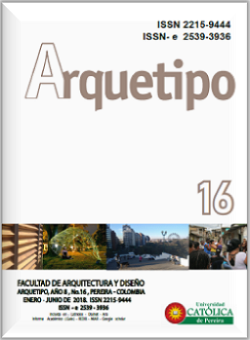Natural lighting strategies in the design of affordable housing: the Mihouse case, Solar Decathlon 2015
Keywords:
Economic housing, Daylighting, solar decathlon, lighting performanceAbstract
In the design of low cost housing without air conditioned incorporated, the design of windows for guaranteeing adequate lighting levels seems to be an efficient architectonic strategy. In that context, computational simulation results to be an invaluable resource for predicting luminous performance. With the aim to obtain reliable and useful results in daylighting simulation, it´s important, among other, to specify adequate sky types and to use correct metrics. This paper describes the daylight incorporation process into Solar Decathlon 2015´s MIHOUSE prototype and evidences the difficulties founded in the daylight performance evaluation process by using Daylight Factor in the municipality of Cali, Colombia.
References
Bardhan, R. & Debnath, R. (2016). Towards daylight inclusive bye-law: Daylight as an energy saving route for affordable housing in India. Energy for Sustainable Development, 34, 1-9.
Bodart, M., De Peñaranda, R., Deneyer, A., & Flamant, G. (2008). Photometry and colorimetry characterisation of materials in daylighting evaluation tools. Building and Environment, 43(12), 2046-2058.
Bouberkri, M. (2008). Daylighting, architecture and health. New York: Routledge.
Bouberkri, M. (2014). Daylighting Design: Planning Strategies and Best Practice Solutions. Alemania: Birkhäuser.
Bullaro, L. (2015). Módulos habitacionales ecológicos. Arquetipo, 11, 7-23.
Filippín, C. (2005). Uso eficiente de la energía en edificios. Santa Rosa, La Pampa: Ediciones Amerindia.
IEA International Energy Agency. (2016). Key World Energy Trends. Excerpt from: World Energy Balances. Disponible en https://www.iea. org/publications/freepublications/publication/KeyWorldEnergyT ends.pdf
ISO/CIE (2005). ISO 8995:2002 CIE S 008/E 2001 Lighting of indoor work places. Technical corrigendum 1.
Mardaljevic, J. (2013). Rethinking daylighting and compliance. Journal of Sustainable Design & Applied Research, 1(3). doi:10.21427/D7HJ0C
Meek, C. & Van Den Wymelenberg, K. (2015). Daylight and integrated lighting design. Oxon: Routledge / Norma Técnica Colombiana.
Ministerio de Minas y Energía (2010). Anexo General: Reglamento técnico de iluminación y alumbrado público. Bogotá: Retilap.
Ministerio de Minas y Energía (2016). Plan de acción indicativo de eficiencia energética –PAI PROURE 2017 – 2022. 2016. Bogotá: Autor.
Monteoliva, J. y Pattini, A. (2013). Iluminación natural en aulas: análisis productivo dinámico del rendimiento lumínico-energético en clima soleado.Ambiente Construido; 13(4) 235-248.
Pérez, Ri., Seals, R. & Michalsky, J. (1993). All-weather model for sky luminance distribution—preliminary configuration and validation. Solar energy, 50(3), 235-245.
Ramos, H., Bedoya, A. y Agudelo, C. (2017). El confort en la vivienda social en Colombia. Caso las 100.000 viviendas gratis y su implementación en Barranquilla, Colombia. Arquetipo, 14, 45-68.

